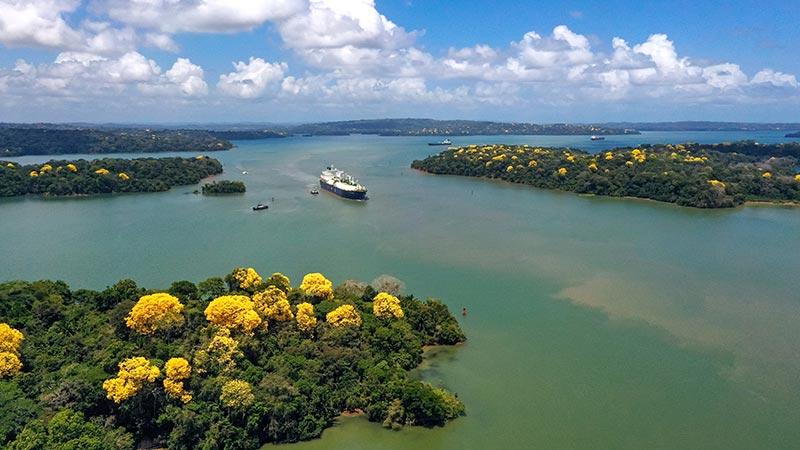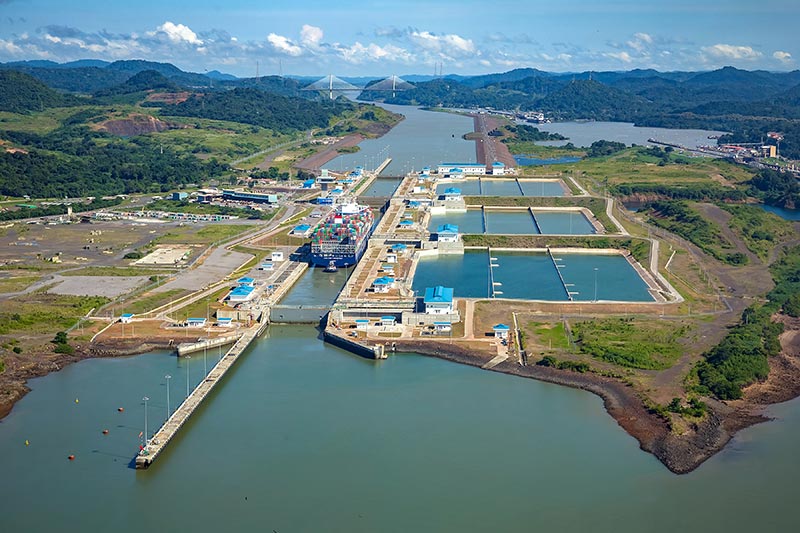Stable draft during the dry season in 2022
After maintaining a stable operating draft during the dry season, the interoceanic waterway focuses on long-term water-saving projects.
Two years ago, the Panama Canal faced an unprecedented dilemma. After months of drought, rainfall on the waterway was about 90% below the historical average in December, making 2019 one of the driest years on record.
However, December 2019 was just the beginning of the dry season, leaving the Canal with the enormous challenge of managing the water shortage for the rest of the season. Managing water to provide acceptable drafts for customers and ensure water availability for the population in the coming months, required innovative solutions.
Two years later, the dry season still represents an annual challenge for the waterway, as its operations must adapt to ensure that the water saved during the rainy season is sufficient for operations and the supply of drinking water to the population for the coming months.
However, the Panama Canal is in a very different situation today than it was two years ago. Despite the fact that in March the country was in the middle of the dry season, the waterway continued to offer customers its highest draft level.

Water conservation is non-negotiable: our country and our customers depend on the Panama Canal to save as much fresh water as possible. Proper water stewardship by our team is now the primary way we deliver value.
In the coming years, climate change is expected to have a major impact on the availability of water resources in the Panamanian waterway and around the world. Therefore, to guarantee the valuable service it provides to its customers, the Canal has prepared procedures, technologies and long-term investments to ensure the reliability of the route during the coming years.
The continued value of water-saving measures
The Panama Canal and water will always be intrinsically linked. The interoceanic waterway’s reservoirs are the main source of the water resource for the transit of more than 13,000 vessels that transported more than 516 million Panama Canal tons (PC-UMS) last fiscal year, as well as for more than half of Panama’s population.
When lake levels dropped two years ago, the Canal responded by implementing measures designed to protect operational water levels while maintaining a certain level of reliability for its customers.
These actions included the freshwater charge, transparent data sharing of Gatun Lake levels, and adjustments to its reservoir system to ensure efficient use of water during transits.
The Canal also introduced water conservation measures in its operations during the dry season. For example, the implementation of cross-filling in the locks, a technique that sends water between the two lanes in the Panamax locks during transits, generates savings equivalent to the total of six lockages per day.
Within three months of implementing these changes, lake levels stabilized. By September 2020, the Canal was once again able to offer customers its highest draft at the Neopanamax locks, 50 feet, a significant increase from the 43 feet available a year earlier. Despite the increased rainfall this dry season, the Canal continues to implement water saving measures.
As a result, the team was able to postpone two draft adjustments in March 2022, allowing customers to continue to benefit from the 50-foot maximum draft.
“Our ability to postpone planned draft adjustments is proof that our team can effectively manage the much-needed water resource to provide our customers with greater reliability,” said Deputy Administrator, Ilya Espino de Marotta.
Maintaining these measures remains critical for customers, as the Canal’s operating draft directly impacts the volume of cargo a vessel can transport through the waterway. This, in turn, benefits their performance and global supply chains. For each additional foot of draft, a container vessel can carry an additional 300 full containers.
However, the Panama Canal expects that shipping lines will continue to consolidate more cargo on fewer ships due to changing global supply chains, which have become even more volatile since the COVID-19 pandemic. This trend will bring larger ships with more cargo to the Panama route, hence the importance of safeguarding this operational draft in the future.

Investments advance to ensure reliability for decades to come
To adapt to future industry and consumer trends, the Panama Canal is moving forward with plans to build a water resource management system, which will encompass a series of projects designed to guarantee an ample supply of water in the long term, while protecting the environment and taking into account variations as a result of climate change. The system is expected to require an investment of B/. 2 billion, making it one of the most essential projects of the interoceanic waterway since the Canal expansion. The Canal aims to complete conceptual design work by 2024, with the goal of completing the project portfolio by 2028.
“We can no longer pretend that water is an abundant resource. To safeguard the development of our customers, as well as international trade and the livelihoods of millions of people, we must make significant investments in resilient solutions now,” said Administrator Ricaurte Vaquez Morales.
He added that this project, and the Canal’s ongoing efforts, “reinforce our role as a constant partner to our customers and as a driver of economic progress and environmental stewardship.”